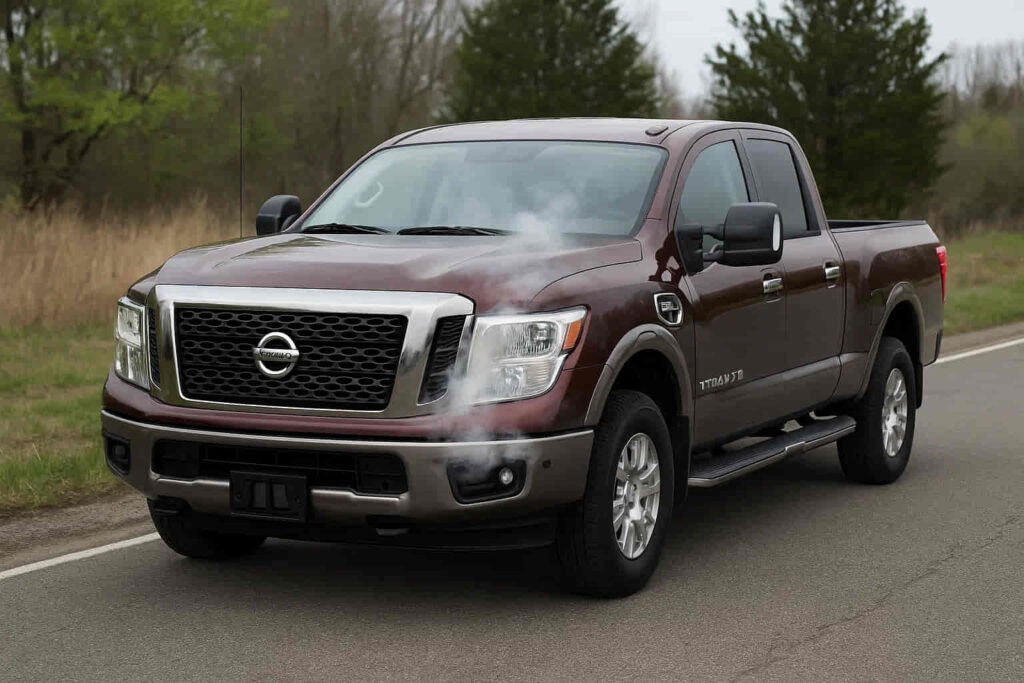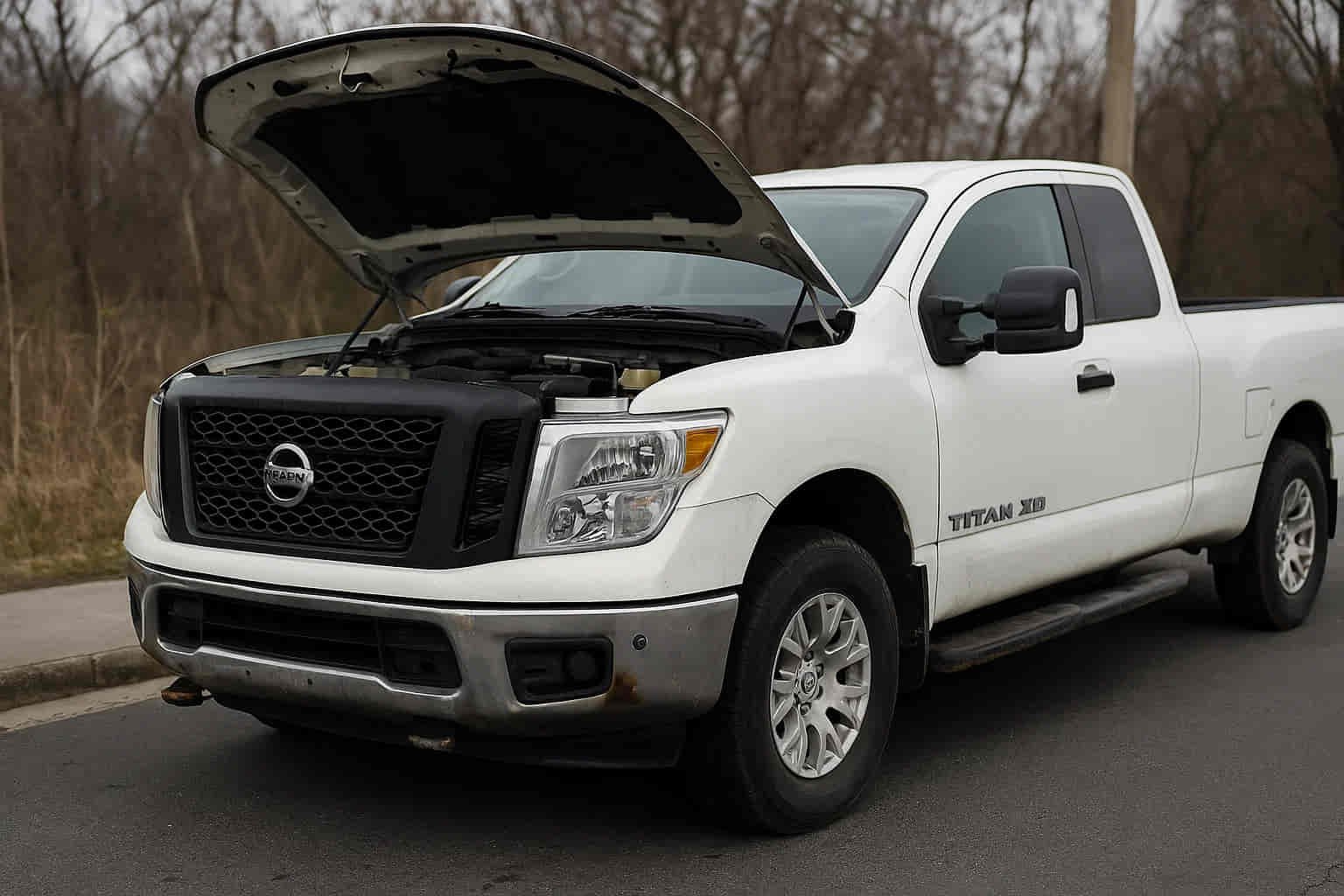When the Nissan Titan XD Diesel first hit the market, it promised to bridge the gap between light-duty and heavy-duty trucks — delivering towing strength without the bulk of a full-size workhorse. Backed by a 5.0L Cummins V8 engine, it looked like the perfect answer for drivers who needed muscle with modern refinement. But as the years went by, many owners discovered that power came with a price: the now-infamous Nissan Titan XD Diesel problems.
From unexpected check-engine lights to complex DEF system failures, the Titan XD Diesel’s reliability became one of the most debated topics in truck communities. What once symbolized innovation turned into a cautionary tale for diesel enthusiasts. Still, for every complaint, there’s a solution — and understanding the real causes behind these issues can save you thousands of dollars in repairs and frustration.
This 2025 guide dives deep into the most common Nissan Titan XD Diesel problems, uncovering what truly goes wrong, why it happens, and how owners can fix or prevent these costly breakdowns. Whether you already drive one or are considering buying used, this article will give you the clarity that most dealership brochures won’t.
Overview: Understanding the Nissan Titan XD Diesel and Its Cummins Engine
The Nissan Titan XD Diesel entered the scene with bold ambitions — to deliver a truck that could tow like a heavy-duty rig but drive with the comfort of a half-ton pickup. Under its hood, the 5.0L Cummins V8 diesel engine stood as the centerpiece of that promise. Designed for torque, durability, and long-haul performance, it immediately caught the attention of drivers who valued both power and practicality.
However, the integration between Nissan’s drivetrain and Cummins’ engineering wasn’t without challenges. The Titan XD Diesel sat in a unique category — too powerful for traditional light-duty maintenance cycles, yet not built for the punishing demands of commercial heavy-duty trucks. This “in-between” design created a perfect storm for mechanical stress.
The Cummins V8 itself is an engineering marvel, but when paired with Nissan’s transmission, emissions control systems, and electronic components, it introduced new layers of complexity. Each system relied on perfect calibration — something that, over time, proved difficult to maintain. Understanding how these elements interact is key to diagnosing the Nissan Titan XD Diesel problems that owners commonly face today.
The Most Common Nissan Titan XD Diesel Problems

DEF System Failure (Diesel Exhaust Fluid)
Among all the Nissan Titan XD Diesel problems, the DEF system failure remains one of the most frustrating for owners — not because it’s catastrophic, but because it can disable the truck’s performance almost instantly. The Diesel Exhaust Fluid system was designed to reduce emissions by converting harmful nitrogen oxides into harmless water and nitrogen. In theory, it’s an eco-friendly solution; in practice, it’s a delicate system that often turns against its own purpose.
When the DEF sensor malfunctions or the fluid quality deteriorates, the Titan XD’s onboard computer reacts aggressively. A small warning on the dash can quickly escalate to reduced engine power or even a complete limp mode, leaving drivers stranded. The most common cause isn’t engine damage but sensor corrosion, temperature misreadings, or contamination from low-grade fluid.
Experienced technicians recommend regular flushing of the DEF tank and sticking to high-quality DEF brands. For many Titan XD Diesel owners, proactive maintenance can mean the difference between seamless performance and costly downtime. What makes this issue particularly deceptive is how it mimics more severe failures — a reminder that not all Nissan Titan XD Diesel problems originate from the engine itself, but from the systems meant to make it cleaner.
Turbocharger Issues
Few mechanical components define the driving experience of a diesel truck more than its turbocharger. For the Nissan Titan XD Diesel, the turbo was meant to deliver that signature surge of torque and responsiveness. Yet for many owners, it became one of the most common and expensive Nissan Titan XD Diesel problems to surface within the first 60,000 miles.
The turbocharger in the 5.0L Cummins V8 is a precision-built unit — it operates under extreme heat and pressure. When oil quality drops or air filtration fails, even slightly, the delicate turbine blades and bearings begin to wear. What starts as a faint whine under acceleration can escalate into a loss of boost pressure, sluggish performance, or a thick plume of black smoke.
What makes turbo issues particularly deceptive is their slow progression. Drivers often adapt to the change in power until the truck suddenly feels “heavier,” forcing the engine to overwork just to maintain highway speeds. Replacing a turbo can easily exceed $3,000, but preventive measures — such as regular oil changes, high-grade filters, and allowing cool-down time after towing — can extend its life dramatically.
In the context of Nissan Titan XD Diesel problems, turbocharger wear is more than a technical failure; it’s a reminder that even the most powerful engines rely on discipline, not just horsepower.
Fuel Pump or Injector Failure
If the heart of any diesel engine is its fuel system, then the Nissan Titan XD Diesel’s heart has proven to be fragile. Among the recurring Nissan Titan XD Diesel problems, fuel pump and injector failures stand out as both subtle and destructive. Unlike a turbo failure, which announces itself loudly, injector and pump issues creep in quietly — through hard starts, uneven idling, and a gradual loss of power that many owners mistake for transmission lag.
The 5.0L Cummins relies on high-pressure common-rail injection, a system that demands clean, stable fuel and flawless pressure regulation. When contaminants or water enter the fuel lines, the injectors struggle to atomize diesel properly, causing misfires or black exhaust smoke. Over time, the pump can lose calibration, starving the engine of fuel under load. The result isn’t just poor performance — it can trigger cascading failures across the combustion system.
Experienced diesel mechanics often describe these symptoms as “the invisible killer” of the Titan XD. The repair costs vary wildly, depending on whether the damage is limited to injectors or extends to the entire pump assembly, sometimes reaching over $4,000. Preventive action lies in simple habits: refueling at reputable stations, changing filters consistently, and using fuel additives that reduce moisture buildup.
For many, this issue embodies the paradox of Nissan Titan XD Diesel problems — a powerful engine held back not by design flaws alone, but by the precision it demands to stay healthy.
DPF (Diesel Particulate Filter) Clogging
Of all the Nissan Titan XD Diesel problems, few are as misunderstood as the DPF clogging issue. On paper, the Diesel Particulate Filter is a marvel of modern engineering — a ceramic honeycomb that traps soot and burns it off through regeneration. In reality, it’s a ticking timer for drivers who spend most of their time in city traffic or short commutes. The Titan XD’s DPF system depends on sustained highway speeds to reach the temperature required for self-cleaning, but when that cycle never completes, the filter suffocates the engine.
Owners usually notice the first signs through reduced power, rough idling, or a warning light that refuses to disappear. It’s not that the engine is failing — it’s literally choking on its own exhaust. The truck’s ECU reacts by forcing regeneration cycles more frequently, consuming extra fuel and wearing down components faster. Many Titan XD owners report that a single missed regeneration can spiral into full DPF replacement, which can cost thousands.
The real fix isn’t magic — it’s maintenance awareness. Taking the truck on periodic highway runs, using the correct grade of diesel oil, and ensuring the EGR system is clean can dramatically reduce soot buildup. For anyone researching Nissan Titan XD Diesel problems, understanding how the DPF works is the difference between frustration and reliability. The system isn’t flawed by design; it’s betrayed by driving habits that never let it breathe.
Transmission Overheating
While most discussions about Nissan Titan XD Diesel problems center on the engine and emissions systems, one of the most quietly destructive issues hides in the transmission. The Titan XD’s Aisin six-speed automatic gearbox was engineered to handle impressive torque numbers, but in real-world use — especially when towing heavy loads — heat becomes its worst enemy. Transmission overheating doesn’t happen suddenly; it builds slowly through repeated strain, inadequate cooling, and neglected fluid maintenance.
Owners often first notice it as a subtle delay between gear shifts or a faint burning odor after hauling. Over time, fluid breakdown leads to reduced lubrication, which means internal clutches and solenoids work harder just to transfer power. Once the temperature consistently crosses the safe threshold, slippage and erratic shifting follow, often misdiagnosed as software glitches or sensor issues.
What makes this problem so critical is its compounding nature — the hotter the transmission runs, the faster it degrades. Preventive solutions exist but require discipline: timely fluid changes, upgraded transmission coolers, and avoiding extended idling after towing. Some Titan XD owners even retrofit auxiliary cooling systems to stabilize operating temperatures.
Among the broader spectrum of Nissan Titan XD Diesel problems, transmission overheating serves as a lesson in mechanical empathy. The truck’s capability is real, but it demands respect — understanding that heavy-duty performance doesn’t excuse neglect. The Titan XD can endure, but only when the driver treats it like the precision machine it truly is.
Minor But Frequent Issues
Beyond the headline failures that dominate forums and repair shops, there’s a quieter category of Nissan Titan XD Diesel problems that chip away at owner confidence over time. These are not catastrophic breakdowns but persistent inconveniences — the kind that make a truck feel unreliable even when it technically runs fine. Electrical glitches are among the most common culprits: flickering dashboard lights, erratic sensor readings, and intermittent glow plug warnings that vanish just as suddenly as they appear. These issues rarely leave the driver stranded, but they create constant uncertainty.
Then there’s the EGR valve, the component responsible for recirculating exhaust gases to control emissions. In many Titan XD Diesels, carbon buildup within the EGR passage clogs airflow, leading to rough idling and thick, black smoke under acceleration. While the symptom looks dramatic, the underlying cause is a design compromise — a system optimized for clean operation but highly sensitive to short-trip driving. Regular cleaning or replacement restores balance, but few owners realize the importance until performance drops noticeably.
Cooling system leaks round out this category of smaller yet frustrating problems. Radiator fittings, hoses, and the fan clutch have shown premature wear, especially in warmer climates or under heavy towing. The result isn’t immediate overheating but a gradual loss of efficiency that stresses both the engine and transmission.
These recurring Nissan Titan XD Diesel problems may seem minor in isolation, but together they erode trust. They remind owners that durability isn’t only about engine strength; it’s about the harmony of countless supporting systems that must work flawlessly — even when the truck isn’t under heavy load.
Real Owner Experiences: What Titan XD Diesel Drivers Say
When it comes to understanding Nissan Titan XD Diesel problems, no technical bulletin or service manual can rival the raw honesty of real owners. Across online communities — from Titan forums to Reddit’s r/trucks — a consistent narrative emerges: the Titan XD Diesel inspires both deep loyalty and deep frustration.
Many owners describe the truck as “brilliant when it works,” praising its smooth towing manners and the unique character of the Cummins V8. But those same voices often follow with stories of recurring check-engine lights, unpredictable DEF warnings, or the creeping anxiety of not knowing when the next issue will appear. For long-distance drivers and contractors, downtime means lost income, not just inconvenience — turning reliability into an emotional and financial burden.
There are, however, stories of redemption. Drivers who adhere strictly to maintenance intervals, use premium fluids, and allow the engine to cool properly after towing often report flawless operation well beyond 150,000 miles. These experiences reveal an important truth: the Titan XD Diesel isn’t inherently unreliable — it’s intolerant of neglect.
Technicians who specialize in the model echo this sentiment, explaining that many Nissan Titan XD Diesel problems stem from mismatched expectations. The truck looks like a half-ton, but it demands the discipline of a heavy-duty diesel. Owners who understand that balance often find satisfaction where others found regret.
Real Fixes and Preventive Maintenance (Action Cluster)
Solving Nissan Titan XD Diesel problems isn’t just about replacing parts — it’s about understanding the behavior of a diesel system that demands consistency. Owners who have managed to transform their Titan XD from unreliable to bulletproof often share a single mindset: treat it like an investment, not an appliance.
The first line of defense lies in fluid discipline. Using high-quality synthetic oils, changing filters precisely on schedule, and monitoring DEF levels with care all prevent the chain reaction that leads to bigger failures. The Cummins 5.0L thrives on clean lubrication and predictable thermal cycles. Skipping one oil change or ignoring a DEF alert may not cause immediate damage, but it shortens the life of expensive components — turbo, injectors, and DPF alike.
Some long-time Titan XD owners have developed maintenance rituals that border on craftsmanship. They let the engine idle briefly before shutdown to cool the turbo, they run highway stretches weekly to keep the DPF clear, and they inspect transmission fluid not just for level but for smell and clarity. These habits create a rhythm that aligns with how the truck was engineered to operate.
From a broader perspective, addressing Nissan Titan XD Diesel problems is less about fixing flaws and more about restoring balance. The truck performs at its best when the owner becomes part of its maintenance ecosystem — proactive, patient, and precise. Reliability, in this context, isn’t luck; it’s literacy in the language of diesel mechanics.
Is the Nissan Titan XD Diesel Still Worth It in 2025?
By 2025, the conversation around the Titan XD Diesel has matured. It’s no longer a debate of hype versus disappointment, but a reflection on what ownership truly means. For many, the truck has proven its strength — a capable tow rig with a commanding highway presence. For others, it remains a symbol of what happens when engineering ambition meets inconsistent maintenance culture. Whether it’s still worth buying depends less on Nissan’s design and more on the buyer’s mindset.
Used models now dominate the market, and the appeal is obvious: a Cummins-powered truck at a fraction of the price of a new heavy-duty rig. But behind the tempting price tag lies the same equation every diesel owner must solve — are you willing to maintain it like a machine that expects respect? The Nissan Titan XD Diesel problems we’ve explored throughout this guide don’t vanish with mileage or updates; they simply wait for neglect to invite them back.
For the right owner — one who values maintenance precision and understands the nuances of diesel operation — the Titan XD Diesel can still be a dependable companion in 2025. But for anyone seeking a carefree, “just fuel and go” experience, the wiser choice might be a gasoline alternative. Reliability, after all, isn’t inherited; it’s earned through attention, understanding, and respect for mechanical truth.
Conclusion: The Reality Behind Nissan Titan XD Diesel Problems
The story of the Nissan Titan XD Diesel is one of ambition meeting reality. When it launched, the truck carried the promise of redefining what a diesel pickup could be — a perfect balance between brute strength and everyday usability. But over time, Nissan Titan XD Diesel problems reminded owners that innovation always comes with complexity.
From DEF system quirks to turbo and injector wear, every issue we’ve explored tells the same story: the Titan XD is not a bad truck, it’s an uncompromising one. It rewards those who understand diesel dynamics — those who respect warm-up cycles, service intervals, and the subtle language of mechanical feedback. For others, it can feel like a constant test of patience and wallet endurance.
In 2025, the Titan XD Diesel stands as both a caution and a case study. It proves that reliability isn’t just engineered — it’s co-created between the machine and its owner. If you’re considering a used Titan XD, the best decision you can make isn’t simply about the price or the power, but about your willingness to engage with what makes it tick.
Every truck has a personality; this one demands partnership.
Have you lived with a Titan XD Diesel? Share your experience — your insight might just help the next owner drive a better mile.

